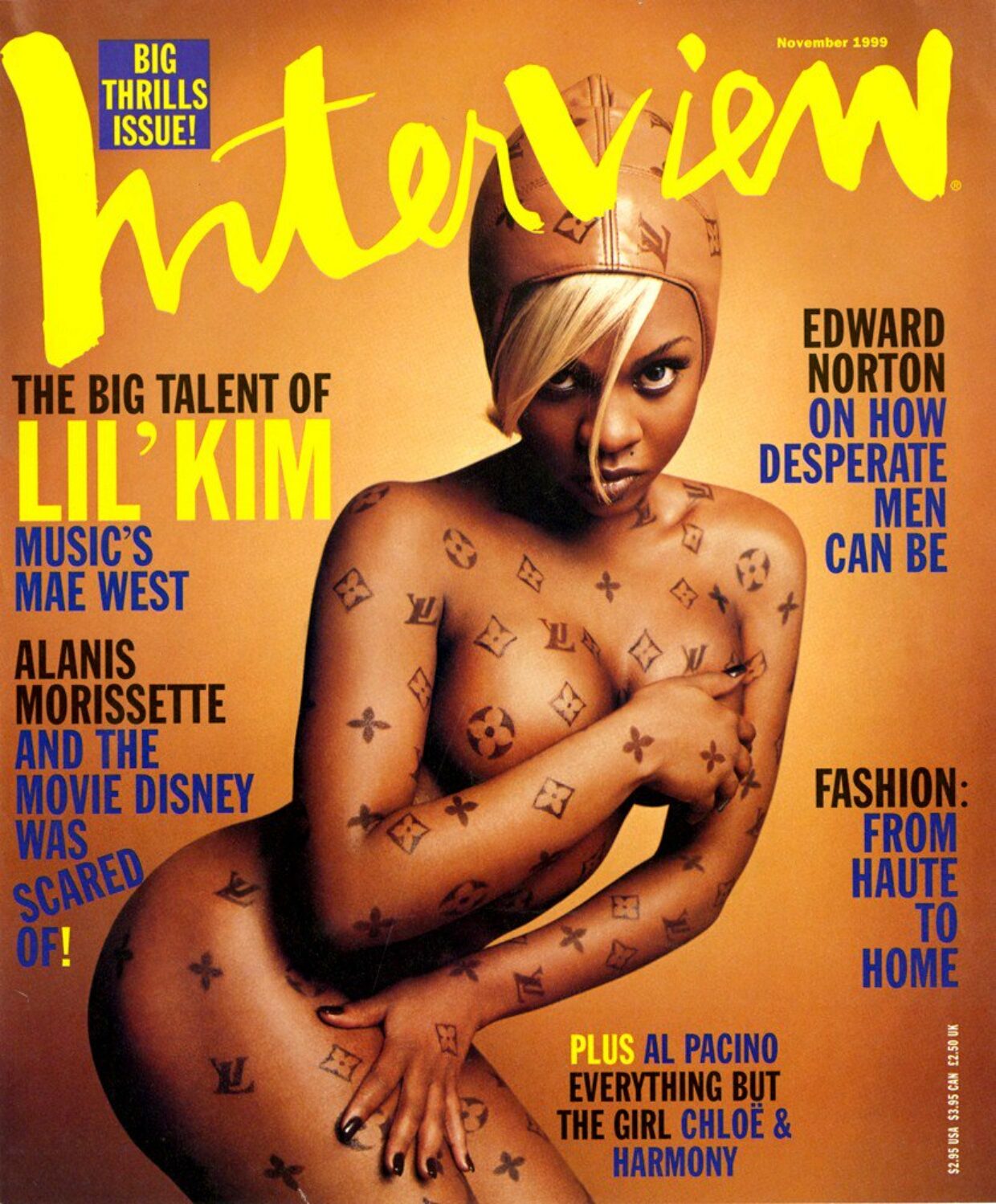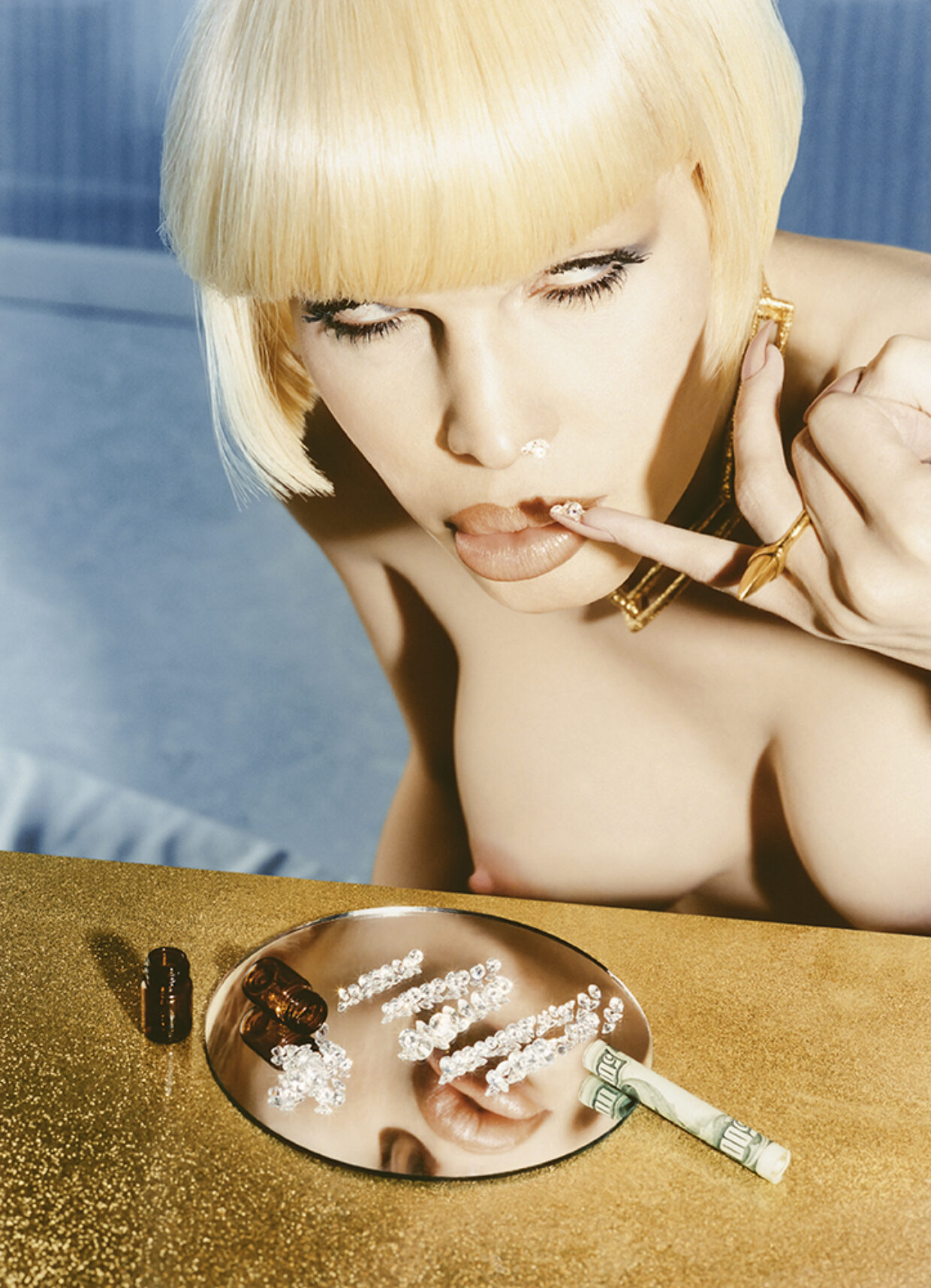The Story Behind Lil Kim’s Iconic Louis Vuitton Logo-Print Portrait
Nov. 5, 2018
By: Nadja Saye
It’s one of the most iconic photos in fashion history: Lil’ Kim nude, covered in Louis Vuitton logos, shot by David LaChapelle. But while it’s been rumored to be a commission by former Vuitton’s creative director Marc Jacobs, LaChapelle has the real story.
“No, it’s not true,” said LaChapelle, sitting down for a coffee in Paris this weekend. “It wasn’t made for Louis Vuitton, but they gave us a cease and desist after it was made. Now they own it. Go figure.”
The photo and more are part of LaChapelle’s solo show at Galerie Templon, “Letter to the World”, which showcases over 40 images by the legendary Pop art photographer. From early works from the 1980s to his iconic portraits of Paris Hilton and David Bowie made during his days at Andy Warhol’s Interview, there’s even a Kardashian Christmas card, pre-Caitlyn.
But wait a minute—back to that Lil’ Kim image. Vuitton owns it?
“They own an edition,” LaChapelle’s assistant jumps in to correct him.
The iconic image didn’t start out as a grand gesture. In fact, it all started at another exhibition, in 1999, when LaChapelle put “Lil’ Kim: Luxury Item” in his New Photographs exhibit at the Tony Shafrazi Gallery in New York.
As soon as then-Interview editor Ingrid Sischy walked in, she demanded it for the magazine, telling LaChapelle: “Take it down!”
He took the image off the wall and put it in the back room of the gallery, then called Lil’ Kim and asked her: “That photo we did with that Louis Vuitton thing…. Can Interview use it as a cover?”
But Lil’ Kim already had plans to use the photo for Chocolate Singles, a free magazine based out of Queens, which was available on the New York subway. He had to convince Lil’ Kim to let the magazine use it, telling her, “Interview is a really important magazine,” and, “You have to trust me.”
After it was published on the November 1999 cover of Interview, the New York fashion scene went bananas for Lil’ Kim, and she rose to superstardom. “I was working with her a lot and just had lots of ideas,” he said.
And to think this one picture was made for play, with no commission from a brand or magazine. “I introduced Lil’ Kim to Giorgio Armani and it was a big, big deal when that happened,” said LaChapelle. “There wasn’t this connection between rap music and high fashion back then; it didn’t happen yet. Now, everyone works hard to be seated next to Anna Wintour at Fashion Week.”
The photo helped propel the crossover between hip-hop and high fashion, almost two decades before Cardi B was rapping about Louboutins, and happened within the same year that Puff Daddy and Jay-Z launched their own sportswear lines.
“When I did that image, it was about the skin as a luxury item,” said LaChapelle. “I was taking cues from Harlem designer Dapper Dan. Logos hadn’t come back yet [into runway fashion]; that happened a season or two later.”
The Vuitton logos were applied with a stencil and airbrush. “I was questioning this idea of materialism,” said LaChapelle. “That was a bit of an outsider opinion, since I was working in fashion.”
Though LaChapelle was shooting Lil’ Kim pretty often in the early aughts—he shot her as a blow-up doll and as a police officer—this one shot of her became her trademark image. In 2013, the print sold at Sotheby’s for $20,000.
LaChapelle left New York to live on an off-grid farm in rural Maui in 2006. Unsurprisingly, he started making non-celebrity photos, some of which are on view here in Paris. “Working full time with those pop stars, yeah,” he said, trailing off. “After a while, I wanted to take pictures with more layers and meaning, as I was thinking about different things about the world in my 30s and 40s than I was in my 20s.”
Yet, LaChapelle will always be known for his photos of celebrities, especially his three female muses—Amanda Lepore, Courtney Love, and Pamela Anderson. “They’re archetypes,” he says. “Courtney Love is the wild child rock star who has that wild, live-for-the-moment energy. Amanda Lepore is a cartoon idea of a woman, like a Jessica Rabbit, and Pamela Anderson is this Pop art California woman with the suntan for a Malibu billboard. She’s a Hollywood blonde bombshell.”
It’s strange to see the Kardashian family Christmas card from 2013 on view, which shows the family sprawled across what appears to be a disheveled casino covered with tabloids, one of which features an image of Kanye West as Jesus while the symbol of the Illuminati’s all-seeing eye lurks in the background.
Then again, LaChapelle recently shot Kim Kardashian’s latest campaign for KKW Beauty, with one photo showing the reality star posing with one finger pointed upward, not unlike Salvator Mundi. The photographer saw a crossover between Mary Magdalene, whose sinful reputation got her name mentioned more than her male disciples in the gospel, and the popular Kardashian sister.
“Mary Magdalene was the person people had the most comments and opinions about” during Jesus’s lifetime, he said. “And yet, people are really obsessed with Kim; she’s this person of our time who has had this insane influence on people’s body shapes. I just thought how to photograph her like a Mary Magdalene figure.”
LaChapelle almost goes into full-on prayer mode when talking about Kardashian. “Kim has this insane following on Instagram and people spend so much time writing these mean, awful, and evil things,” he said. “Judgment. I thought it was about judgment. Everyone has an opinion about her. That was the crux of it: the story about Mary Magdalene was about judgment. A keynote in the teach[ings] of Christ was not to judge others.”
Here, in Letter to the World, LaChapelle’s new work suggest that there is hidden wisdom in photography, but also in the everyday. “There are details I want people to notice,” he said. “If I don’t have a story to tell or a message to say in my photos, then I don’t take the photo. I don’t want to make more merchandise or more things in the world. There’s enough stuff in the world already.”
Source: GARAGE




